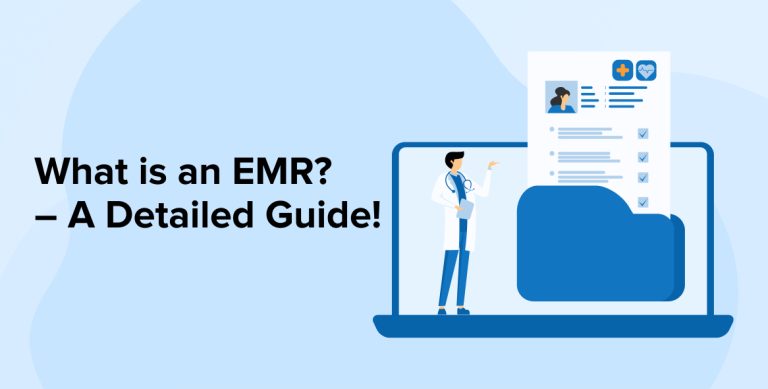
The Healthcare system is undergoing a dramatic and long-awaited transformation all thanks to the advanced Healthcare software development solutions. Now more than ever, people all across the world have access to cutting-edge methods of diagnosis, therapies, and information technology that may improve the quality of care provided and eliminate errors and waste.
Electronic medical records (EMR) are a cutting-edge concept that may benefit both patients and doctors. A patient’s medical paper records have never been 100% accurate, and there are various threats to their security that are difficult to manage without the aid of modern technology.
However, what is an EMR in a particular sense, and how does it function if it has been adopted by so many systems and facilities? Let’s find out in this article!
1. What Is an Electronic Medical Record (EMR)?
Data such as patient health information like current diagnoses, prescriptions, vaccination dates, sensitivities, lab results reports, and doctor’s comments can all be found in an electronic medical record (EMR), which is a digital counterpart of the traditional paper chart. Electronic medical records (EMRs) guarantee that patients receive the best possible care by recording every detail of their medical records, diagnostic procedures, and treatments.
Electronic medical records (EMRs) serve more than one purpose. They facilitate the sharing of information and collaboration among medical professionals, leading to better treatment for patients.
Its development was inevitable, and it started in the 1960s when “problem-oriented” health files appeared alongside a doctor’s analysis and therapy. This marked the first time that a report could be independently confirmed by a separate set of facilities.
2. What Should You Know About Electronic Medical Records (EMRs)?
Electronic medical records are meant to replace paper charts and improve the efficiency of a practice’s internal paperwork and data administration.
Electronic health records (EMRs) are not easily portable; therefore, information cannot be shared among other healthcare organizations or networks without approval..
Electronic medical records (EMRs) are often tailored to the needs of a single institution or medical subspecialty in terms of how they operate and the methods they use. Accordingly, there are Electronic Medical Record systems that are tailored to certain fields, such as Pediatrics or Cardiology. Electronic health records (EMRs) tailored to certain specialties streamline treatment delivery, paperwork, and billing by providing pre-built templates and other capabilities.
Electronic medical records (EMRs) may contain medical decision assistance and associated services like lab and radiology, but they are structured in a way that best serves the requirements of the particular doctor and clinic.
3. EMR vs. EHR: What’s the Difference?
Both EMR and EHR are the systems used to store patient data. But unlike EHR, EMR isn’t easily transferable to other healthcare providers. EMR can be used in a particular office and not in multiple medical practices like EHR.
Further Reading on:
EMR vs EHR : What Are the Differences and Benefits?
4. The Advantages of an Electronic Medical Record
4.1 Benefits of EMRs for Patients:
- Incorrect data in a patient’s medical record is minimized.
- Faster medical evaluation and treatment.
- Information and outcomes are monitored throughout time.
- The quality of healthcare including diagnosis, medication, and follow-up, has increased.
- More stringent safeguards for patient information.
- Errors made by patients decrease, and the quality of treatment they receive rises.
- Provide the means for making care decisions depending on data at the moment of delivery.
- Post-visit recommendations for self-care, reminders for further follow-up treatment, and links to relevant online resources.
- Patients will have the option of viewing their own medical data so that they may monitor the effects of any prescribed drugs and track the progress made in maintaining a healthier lifestyle.
4.2 Benefits of EMRs for Clinical Facilities:
- You’ll be able to free up a lot of room by switching to digital records instead of keeping and retrieving paper files.
- Improve efficiency and see a rise in the daily patient count.
- Minimize operating losses and bureaucratic hassles.
- Integrate smoothly with existing healthcare infrastructures, such as clinics, pharmacies, laboratories, and governmental health programs.
- Electronic documents that may be modified and expanded.
- Collect and analyze patient information to target certain groups.
- Give out medical reminders and notifications.
- Enhance the programming and documentation.
- Optimize clinical quality through more monitoring and research.
- Assure that there are built-in checks to prevent doctors from prescribing medications that might cause harm.
- Keep tabs on all the emails sent to patients, doctors, hospitals, laboratories, etc.
- Connections to public health infrastructures like registry and illness database systems.
Electronic medical records (EMRs) “compute” data, which means they manipulate patient data in a useful way rather than merely storing it.
For instance, if a new prescription is provided to a patient, the EMR looks for possible collisions with the patient’s previous prescriptions and medical error status and warns the prescriber.
Electronic medical records provide for the rapid and methodical diagnosis and resolution of operational issues for authorized providers. Finding and fixing such issues is a lot more work and time-consuming with a paper-based system.
Electronic medical records (EMRs) have financial benefits in addition to the systemic and patient-care improvements they bring about. When a clinic’s workflow is well-oiled, it saves money on both its daily running operational costs and its overtime pay for employees. Billing patients more precisely and quickly boosts the clinic’s profits.
If there are any drawbacks to using EMRs, they likely lie at the beginning (and inevitable) or face difficulties with implementation, setup, and training.
5. What Is an EMR System?
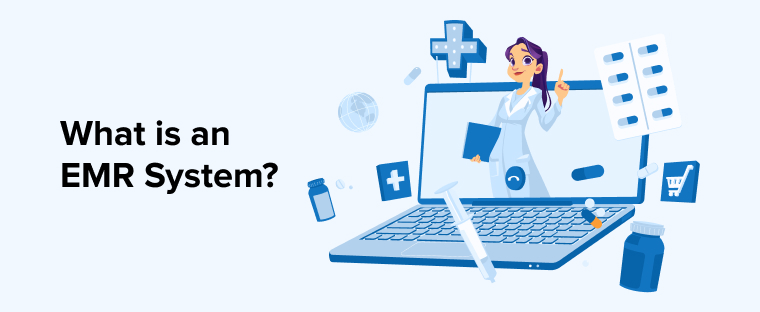
Electronic medical records (EMRs) have quickly become the nerve center of medical practice due to the breadth and depth of their features and user interfaces. Each and every day, the EMR system is utilized for the purposes of handling patient billing and insurance applications, patient appointments, patient information exchange amongst clinic employees, patient onboarding, and patient record maintenance.
Clinics may easily adapt to the legislative and payment shifts brought on by meaningful use attestation, ICD-10, and HIPAA compliant with the help of EMR software solutions.
Every hospital’s EMR adoption will look different depending on factors including the clinic’s unique guidelines, the level of customization desired, the flexibility of clinic employees, and the presence of software professionals. Your hospital will be allocated a professional who will assist you stay on track and answer any questions you may have during the duration of your project.
6. Key Features of EMR Systems
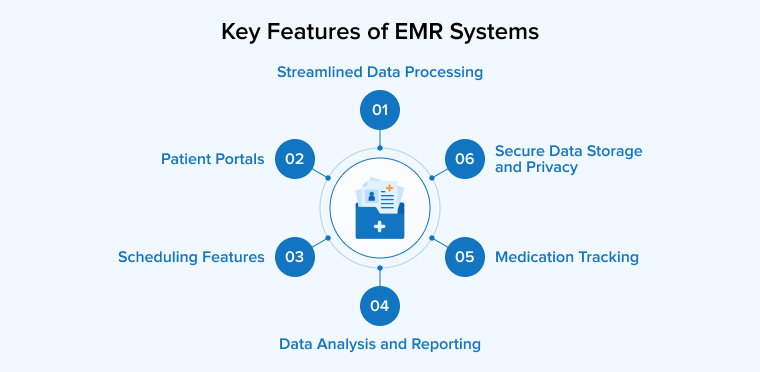
There is a wide range of features available in healthcare software that can be utilized to offer EMR system solutions. Let’s look:
6.1. Streamlined Data Processing
Electronic medical record systems are crucial for healthcare operations since they allow for the effective handling of patient data. A patient’s health statistics, medical history, allergies, prescriptions, test results, radiology reports, course of action, and more can all be easily recorded and organized with their extensive features.
6.2. Patient Portals
To aid in learning, improve communication between patients and doctors, and accelerate the medical treatment process, patient portals are important. Encouraging the needy to schedule appointments online through patient portals is a fantastic method to cut down on administrative work and phone calls. On top of that, it provides patients with a single location to store and access their whole medical record. You can personalize the portal in certain EMR systems to reminders for preventative care and targeted wellness initiatives.
6.3. Scheduling Features
In order to simply maintain track of appointments, scheduling must be done within EMR systems. Doctors can instantly alert patients whenever they plan an appointment, health monitoring, or set a reminder if their scheduling system is integrated with their EMR.
The ability to tailor a scheduling function to fit a particular demand makes it a potent tool. Setting up notifications when tests are ready is one example. With the scheduling functions assembled, you can streamline many administrative tasks and get your calendar and notifications in order, which should increase your productivity.
6.4. Data Analysis and Reporting
You can generate personalized reports, monitor KPIs, and examine data to find behaviors, patterns, and results with the help of EMR systems’ built-in advanced reporting and analytical features. Decisions are often driven by evidence when these analytical insights are used to better manage patients’ health, identify patients at high risk, track quality measures, and more.
6.5. Medication Tracking
The perfect electronic medical record systems include a built-in medication-tracking function that makes it easy to keep tabs on the drugs your patients take and makes all of that data readily available. Determining if a patient’s prescription drug interacts with other medications they are taking is one of the real benefits of medication tracking. Additionally, it can be an effective tool for detecting allergic responses, which can help doctors protect their patients from any negative effects.
6.6. Secure Data Storage and Privacy
EMR systems adhere to data security and patient privacy by implementing strong security regulations including encryption, restricting access, and audit logs. These precautions safeguard patient insights from unauthorized entry or violations and ensure compliance with regulatory standards, such as HIPAA, to maintain the safety and reliability of private healthcare data.
7. Types of EMR Systems

Here are some examples of EMR system types used with specific OSes and environments:
7.1 Certified EMR Systems
Some electronic medical record and electronic health record systems are certified while others are not. If a system has been granted certification, it indicates it has been found to be up to the rigorous standards for reliability and safety established by the Department of the National Coordinator for Health Information Technology.
The certification process is rigorous and considered legitimate. Based to the United States Department of Justice, software providers that commit any form of infraction or breach run the risk of having their certification withdrawn and suffering additional severe penalties.
7.2 Cloud-Based EMR Systems
By utilizing cloud-based technologies, you may access data without physically being in the workplace. Cloud-based electronic medical record software is typically less costly than on-premise systems since the servers are hosted and managed by the software vendor.
7.3 Mental Health EMR Systems
Some electronic medical records are designed specifically for mental health practitioners including therapists, counselors, and doctors. Modern note-taking and patient interaction are only two of the features tailored to the unique needs of mental health providers included in these EMRs.
8. Benefits of EMR Systems
Both doctors’ clinics and their patients can gain from using an electronic medical record system. There are five main types of positive effects that patients and healthcare providers alike should expect to see from widespread EMR use.
These are the improvements that have been noted in patient outcomes:
- Better care for patients during their entire hospital stay.
- Greater efficiency in sharing patient’s medical information and coordinating care.
- Fewer forms to fill out and fewer inconsistencies in the work process translate to time saved and money saved for the practice.
- Raise openness and patient involvement.
- Better diagnosis, better prescription, and enhanced patient health information.
9. Final Words
The healthcare business and society, in general, can profit from electronic medical records (EMRs), and without them, the current state of healthcare technology would likely look very different.
Electronic medical records allow healthcare providers to quickly and easily retrieve a patient’s medical history, which improves efficiency and saves a lot of time. While on the other hand it can take a healthcare provider hours or more to locate a particular paper copy of the patient. Electronic medical records (EMRs) are maintained and organized in a way that makes them extremely user-friendly; for example, health care providers just need to input a name or date of birth to quickly and precisely get the information they need.
Therefore no need to look through piles of medical documents to choose those that match is necessary, it is reasonable to claim that the adoption of electronic medical records can assist in decreasing the possibility of administrative hassles and operational expenses.
FAQ:
Difference between EMR and EHR?
EMR (electronic medical record) and EHR (electronic health record) are both used by medical healthcare providers to record patient’s data and offer improved healthcare services. However, EMR is an internal system that can be only used by one particular office, while EHR can be shared outside the office with other healthcare providers.
What are EMRs used for?
Healthcare providers use EMRs to access patient’s data for diagnosis and treatment.


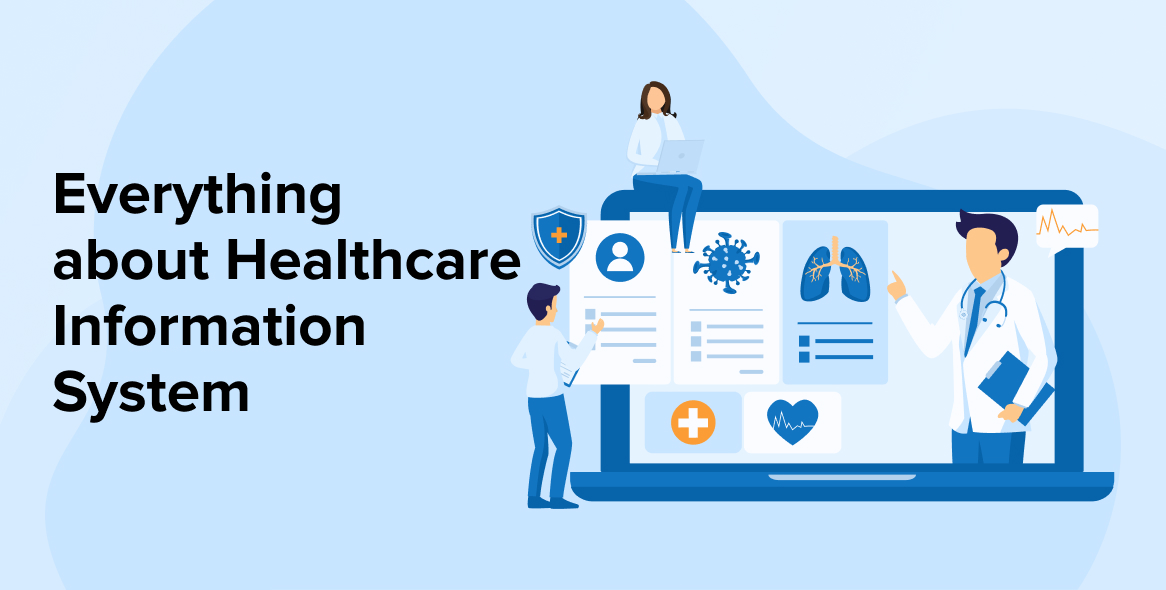
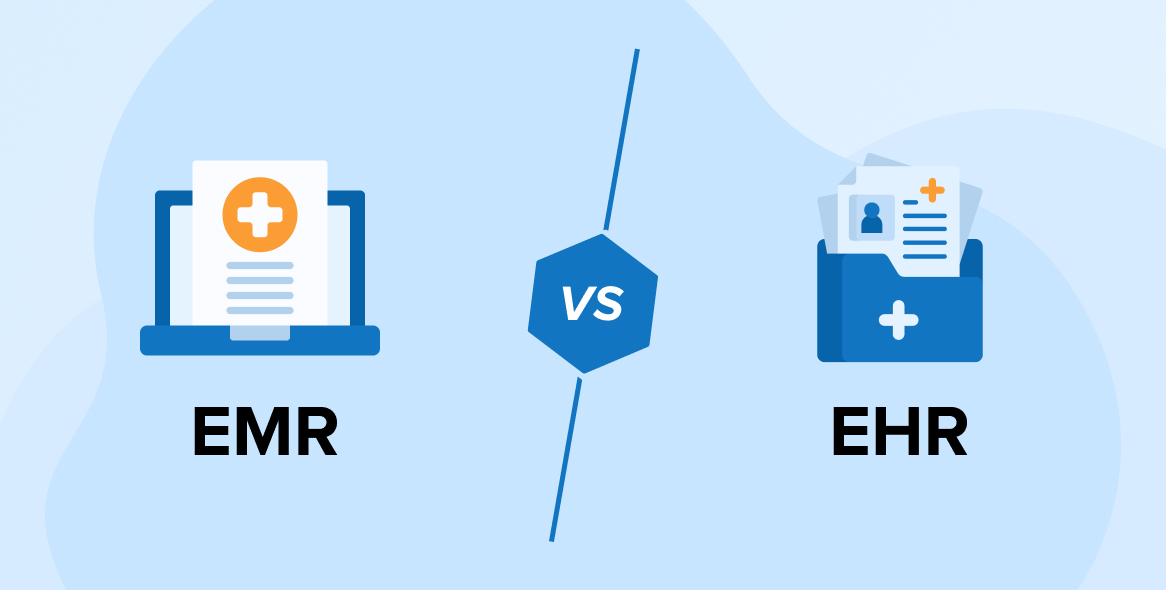
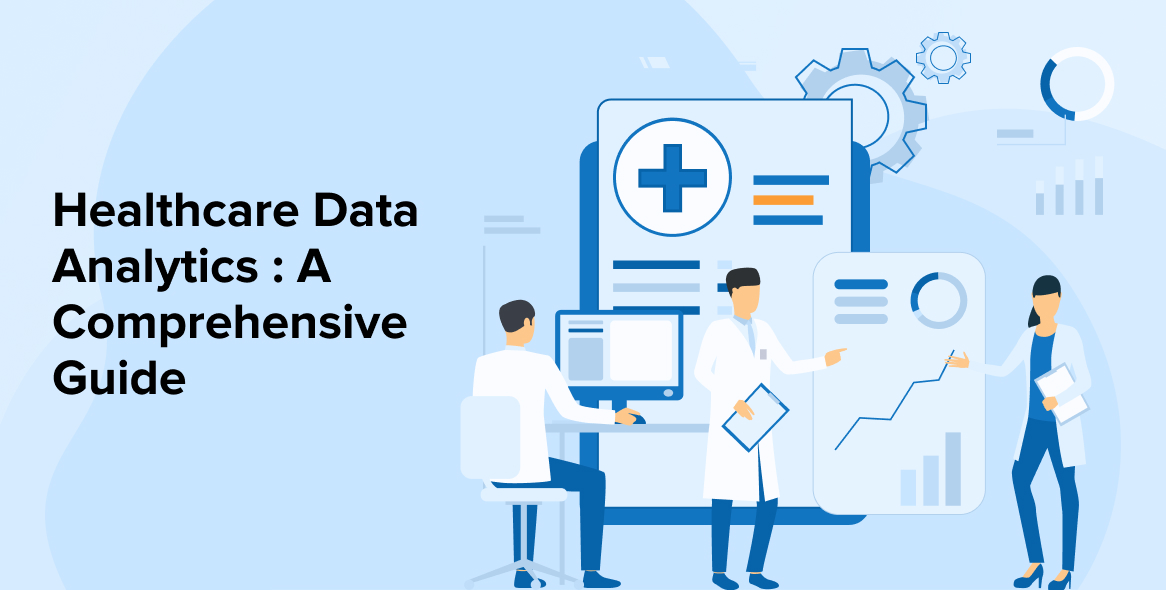

This article provides a comprehensive overview of electronic medical records (EMRs), covering their definition, benefits, types, and more. It is well-written and informative.
In this article, the author discusses the concept of EMR (Electronic Medical Record) in a specific context, elucidating its functionality within numerous systems and facilities where it has been implemented. As a healthcare professional, this article proves immensely beneficial in enhancing my understanding of EMR systems.
This article provides a clear explanation of the advantages of Electronic Medical Records (EMRs) in healthcare. Now I understand why healthcare providers are increasingly adopting EMRs! EMRs seem like an important step forward in modernizing healthcare.